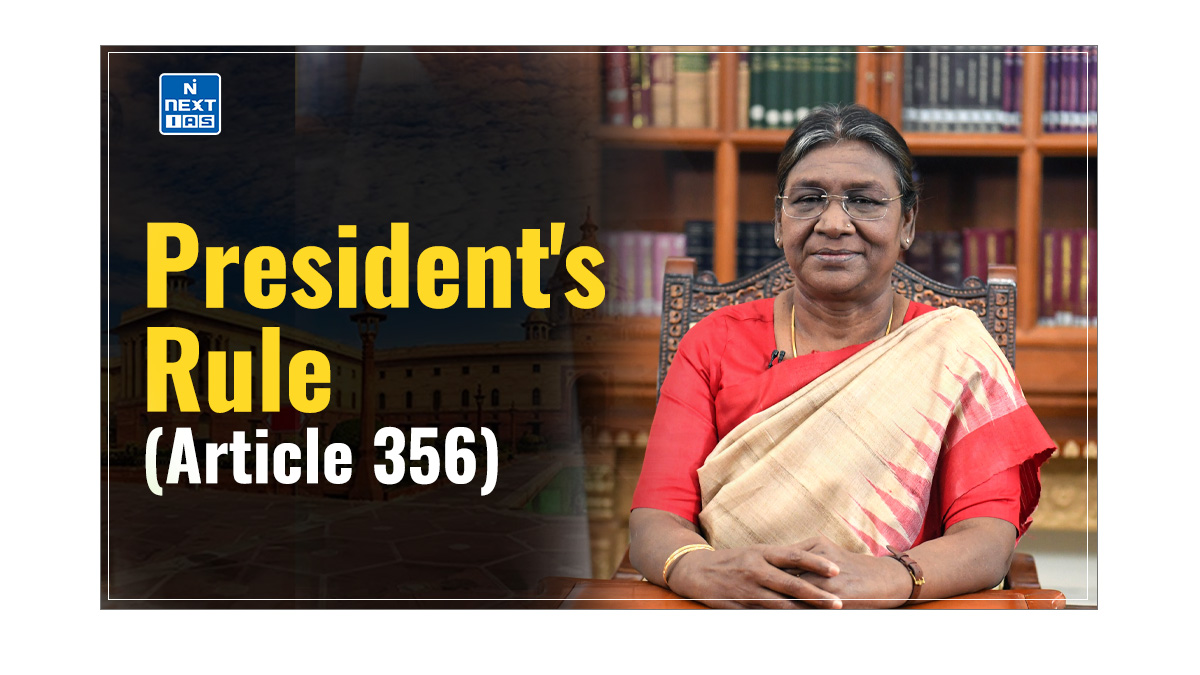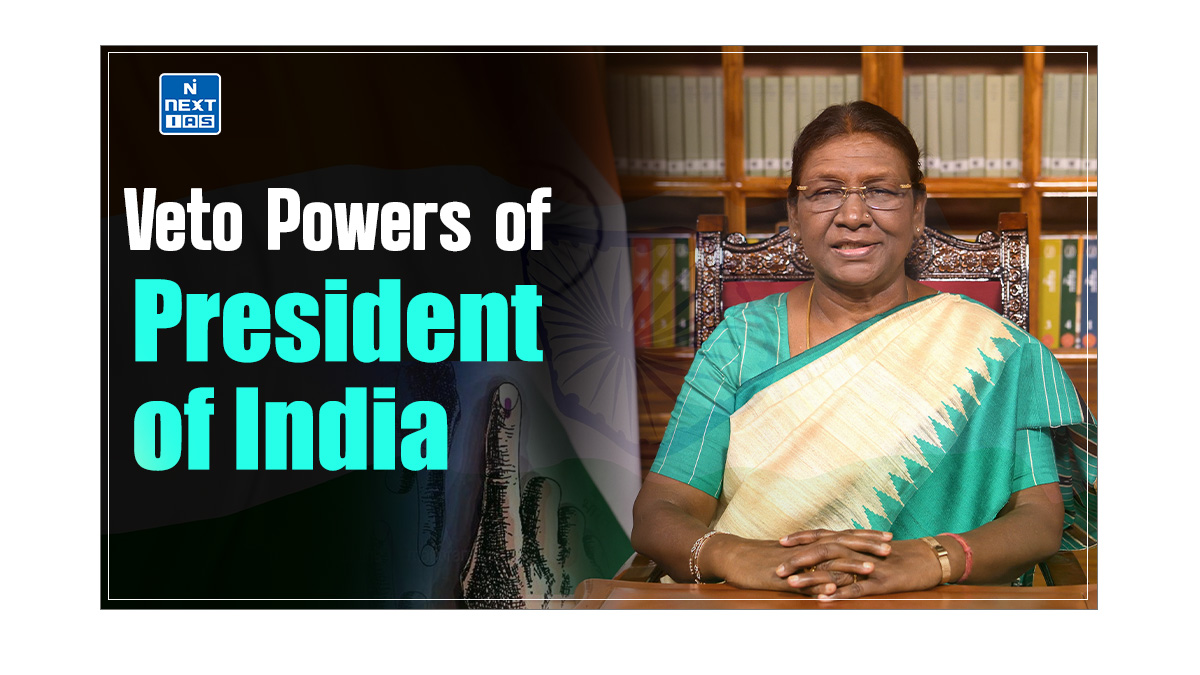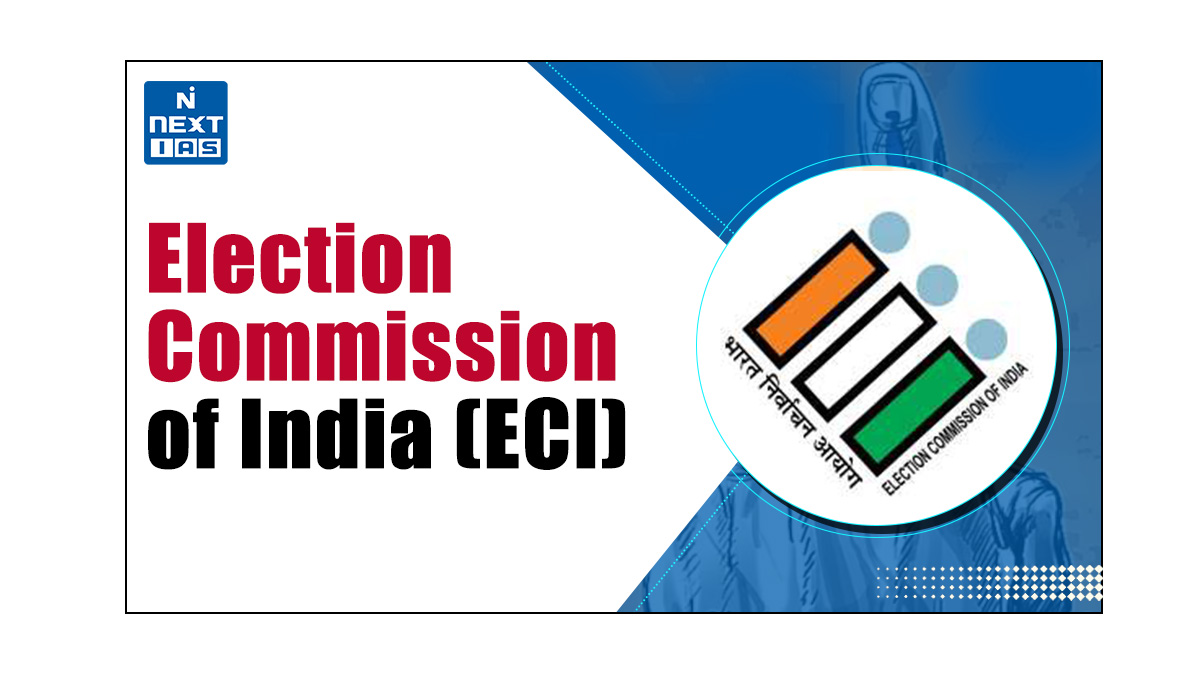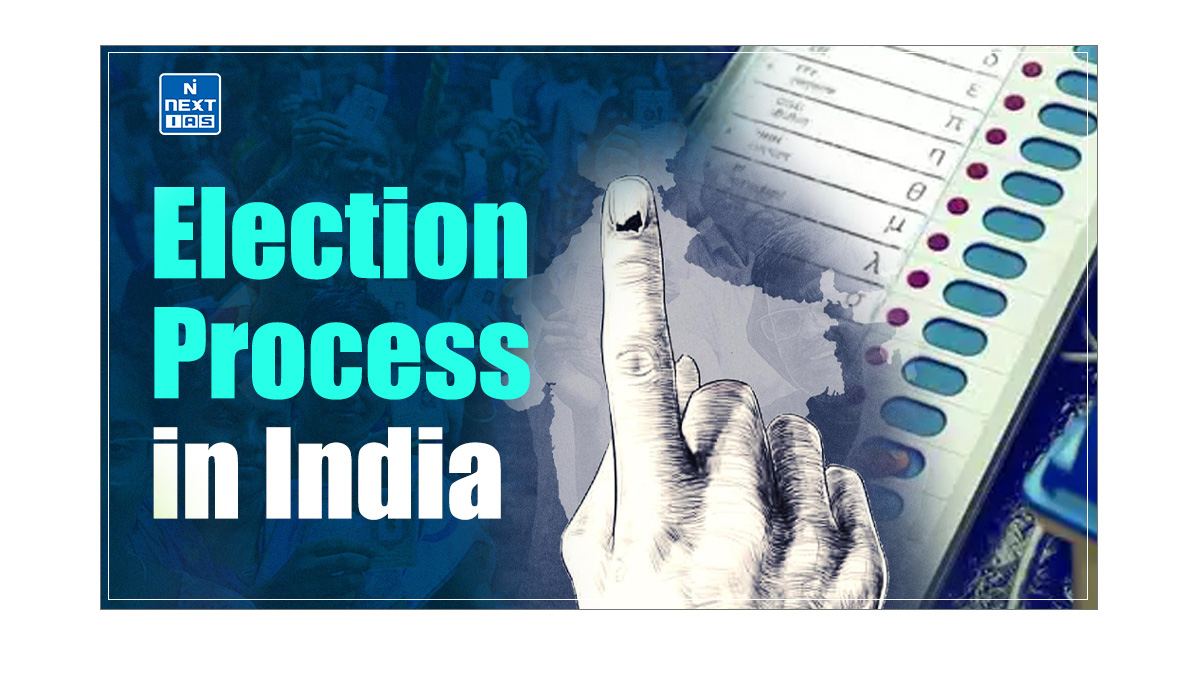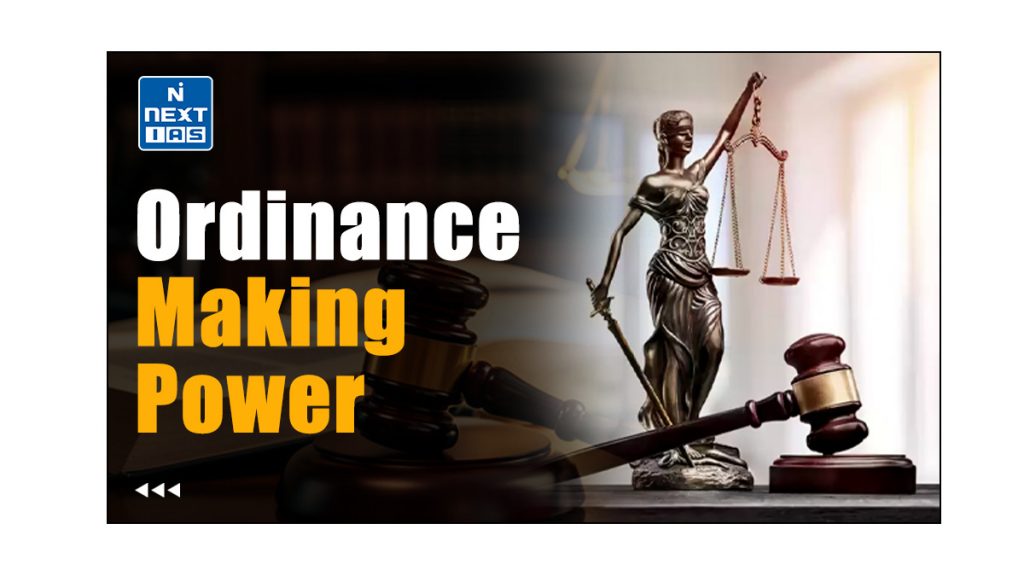
The Ordinance Making Power of President and Governors stands as a unique feature of the Indian constitution. While this power is intended as a tool for efficiency and necessity, it walks a tightrope between pragmatic governance and potential overreach. This article of Next IAS aims to explain the meaning of the ordinance, related constitutional provisions, their significance, and related issues.
What is Ordinance?
- An Ordinance, within the context of governance and law, is a piece of legislation enacted by a non-legislative authority, often the executive branch of government, under specific circumstances.
- The provision of the Ordinance is mainly aimed at enabling the executive to make laws when the legislature is not in session or when an urgent matter demands immediate attention.
- An Ordinance, usually, has the same force and effect as an Act enacted by the legislative body. The only difference between the two is that while an Act is permanent, an Ordinance is of a temporary nature.
Constitutional Provisions Regarding Ordinance in India
The Constitution of India provides for the promulgation of ordinances making power by the President of India as well as the Governors of states. The constitutional provisions regarding the same are as follows:
- Article 123: empowers the President to promulgate ordinances during the recess of Parliament.
- Article 213: empowers the Governor to promulgate ordinances during the recess of the State Legislature.
The ordinance making power of President and the ordinance making power of Governor are discussed in detail in the sections that follow.
Ordinance Making Power of President
- Article 123 of the Constitution empowers the President to promulgate ordinances during the recess of Parliament.
- The Constitution puts the following four limitations on the ordinance making power of President.
- The President can promulgate an ordinance only when either both or one of the Houses of Parliament are/is not in session.
- An ordinance promulgated by the President when both the Houses are in session is void. Thus, the power of the President to promulgate ordinances is not a parallel power of legislation.
- The president can promulgate an ordinance only when he is satisfied that the circumstances exist that render it necessary for him to take immediate action.
- Except for duration, the ordinance making power of the President is coextensive with regard to all matters, with the legislative powers of the Parliament. Thus:
- An ordinance can be issued only on those subjects on which the Parliament has the power to make laws.
- An ordinance is subject to the same constitutional limitation as an act of Parliament. Hence, an ordinance cannot abridge or take away any of the fundamental rights.
- Every ordinance promulgated by the President during the recess of Parliament must be laid before both the Houses of Parliament when it reassembles.
- The Parliament has the following three options w.r.t ordinance making power so brought before it:
- Approve the Ordinance: If both houses of the Parliament approve the ordinance, it becomes an act immediately.
- Disapprove the Ordinance: If both the Houses of Parliament pass resolutions disapproving the ordinance, it ceases to operate immediately.
- Take No Action: If no action is taken by the Parliament w.r.t. the ordinance, it ceases to operate on the expiry of six weeks from the reassembly of Parliament.
- If the Houses of Parliament are summoned to reassemble on different dates, the period of six weeks is calculated from the later of those dates.
- Thus, in case of non-approval by the Parliament, the maximum life of an ordinance can be six months and six weeks.
- This is because the maximum possible gap between the sessions of the Parliament can be six months.
- The following points are to be noted w.r.t. an ordinance making power promulgated by the President:
- If an ordinance is allowed to lapse without being placed before Parliament, then the acts done and completed under it, before it ceases to operate, remain fully valid and effective.
- The President can promulgate as well as withdraw an ordinance at any time.
- However, it is to be noted that the ordinance making power of the President is not a discretionary power. He can promulgate or withdraw an ordinance only on the advice of the Union Council of Ministers (CoM).
- Like any other legislation, an ordinance can be retrospective.
- Thus, it may come into force from a back date.
- As far as the Scope of the Ordinance is concerned, it
- Can modify or repeal any act of Parliament or another ordinance.
- Can amend a tax law.
- Cannot amend the Constitution.
Ordinance Making Power of Governor
- Article 213 of the Indian Constitution empowers the Governor of the State to issue ordinances when the State Legislative Assembly (or either of the two Houses in states with bicameral legislatures) is not in session.
- The ordinance making power of Governor is more or less similar to that of the ordinance making power of President. The same can be better understood by making a comparative study of the ordinance making power of Governors with that of the President.
Comparison between Ordinance Making Powers of President & Governors
The comparison between the ordinance making power of the President and Governor can be seen as follows:
| Similarities |
| President (Article 123) | Governor (Article 213) |
|---|---|
| – He can promulgate an ordinance only when either both or one of the Houses of Parliament are/is not in session. | – He can promulgate an ordinance only when either both or one of the Houses of the State Legislative Assembly are/is not in session. |
| – He can promulgate an ordinance only when he is satisfied that circumstances exist that render it necessary for him to take immediate action. | – He can promulgate an ordinance only when he is satisfied that circumstances exist which render it necessary for him to take immediate action. |
| – His ordinance making power is co-extensive with the legislative power of the Parliament. – This means that he can issue ordinances only on those subjects on which the Parliament can make laws. | – His ordinance making power is co-extensive with the legislative power of the State Legislature. – This means that he can issue ordinances only on those subjects on which the State Legislature can make laws. |
| – An ordinance issued by him has the same force and effect as an Act of the Parliament. | – An ordinance issued by him has the same force and effect as an Act of the State Legislature. |
| – An ordinance issued by him is subject to the same limitations as an Act of Parliament. – This means that an ordinance issued by him will be invalid to the extent it makes any provision that the Parliament cannot make. | – An ordinance issued by him/her is subject to the same limitations as an act of the State Legislature. – This means that an ordinance issued by him will be invalid to the extent it makes any provision that the State Legislature cannot make. |
| – He can withdraw an ordinance at any time. | – He can withdraw an ordinance at any time. |
| – His ordinance making power is not a discretionary power. This means that he can promulgate or withdraw an ordinance only on the advice of the Council of Ministers headed by the Prime Minister. | – His ordinance making power is not a discretionary power. This means that he can promulgate or withdraw an ordinance only on the advice of the Council of Ministers headed by the Chief Minister. |
| – An ordinance should be laid before both the Houses of Parliament when it reassembles. | – An ordinance issued by him should be laid before the Legislative Assembly or both the Houses of the State Legislature (in case of a bicameral legislature) when it reassembles. |
| – An ordinance issued by him ceases to operate on the expiry of six weeks from the reassembly of Parliament. It may cease to operate even earlier than the prescribed six weeks if both Houses of Parliament pass resolutions disapproving it. | – An ordinance issued by him ceases to operate on the expiry of six weeks from the reassembly of the State Legislature. It may cease to operate even earlier than the prescribed six weeks if a resolution disapproving it is passed by the Legislative Assembly and is agreed to by the Legislative Council (in case of a bicameral legislature). |
| Difference(s) |
| President (Article 123) | Governor (Article 213) |
|---|---|
| – He needs no instruction to make an ordinance. | – He cannot make an ordinance without instructions from the President in three cases: – If a bill containing the same provisions would have required the previous sanction of the President for its introduction into the State Legislature. – If he would have deemed it necessary to reserve a bill containing the same provisions for the consideration of the President. – If an act of the State Legislature containing the same provisions would have been invalid without receiving the President’s assent. |
Utilities of Ordinances
The utility of ordinance making power can be seen as follows:
- Emergency Measure: It is a much-needed emergency measure in the hands of the executive to meet any unforeseen situation or an urgent matter. It allows the executive to respond promptly to such matters without waiting for the regular legislative process.
- Unobstructed Governance: There may be instances where certain bills have been adequately deliberated upon in the Legislature, but could not be passed due to the obstructionist approach of the opposition. Promulgation of the ordinance ensures unobstructed governance in such cases.
Limitations of Ordinance Making Power
The limitations of ordinance making power can be seen as follows:
- Violates Separation of Powers: As per the scheme of powers envisaged in the Indian Constitution, the law-making lies in the domain of the Legislature. By allowing the Executive to enter into the Legislature’s domain, the provisions for the ordinance violate the principle of separation of powers.
- Undermines Democratic Principles: At times, the executive takes the ordinance route to avoid debate and deliberations in the legislature on contentious legislative proposals. This undermines the democratic principles.
- Misuse: There have been instances of successive re-promulgation of ordinances, without making any effort to table the corresponding bill in the Legislature.
- As observed by the Supreme Court in the D.C. Wadhwa Case, during the period of 1967-98, some ordinances in Bihar were kept in force for 14 years by successive re-promulgation.
- Fear of Ordinance Raj: Frequent issuance and re-issuance of ordinances create an atmosphere of ‘Ordinance Raj’, where the executive relies on ordinances rather than engaging in meaningful legislative processes.
- Vague Provisions: As per the constitutional provisions, the President or the Governors can issue an ordinance only when he is satisfied that circumstances exist which render it necessary for him to take immediate action. However, with no clear demarcation of urgent circumstances, the Executive has been taking regular reliance on this power instead of treating it as a last resort. Such examples are:-
- Securities Laws (Amendment) Ordinance, 2014: This ordinance was re-promulgated for the third time during the term of the 15th Lok Sabha which raised concerns about the circumvention of the legislative process and the lack of parliamentary scrutiny.
- Indian Medical Council (Amendment) Ordinance, 2010: This ordinance was re-promulgated four times, indicating a persistent disregard for judicial pronouncements and democratic norms.
Views of Supreme Court on Repromulgation of Ordinances
The Supreme Court has expressed its stance on the promulgation and re-promulgation of ordinances in various cases. Some of the prominent such cases are:
- RC Cooper vs. Union of India Case (1970): In this case, the Supreme Court held that the President’s satisfaction regarding the ‘existence of a circumstance that renders it necessary to promulgate an ordinance’ can be challenged in a court of law. Thus, the President’s satisfaction is not immune from judicial review.
- DC Wadhwa vs. State of Bihar Case (1987): In this case, the court condemned the practice of re-promulgating ordinances, labelling it as a ‘fraud’ on the Constitution. It rules that the Executive’s power to promulgate ordinances is to be used sparingly only in exceptional circumstances. It is not a substitute for the legislative power of the legislature.
- Krishna Kumar Singh vs. State of Bihar Case (2017): In this case, the Supreme Court reiterated that the authority to issue ordinances is not absolute but conditional upon the satisfaction that circumstances necessitate immediate action. The court emphasized that the re-promulgation of ordinances is unconstitutional and undermines the democratic process, highlighting the need for adherence to constitutional principles and norms.
In conclusion, while the Ordinance Making Power is a desirable tool in the hands of the government, it must be used with caution. Balancing the need for addressing urgent matters with the imperatives of the doctrine of separation of powers is crucial. Only through such a balance can the Ordinance Making Power serve its intended purpose without undermining the democratic foundations it seeks to protect.
| The Doctrine of Colorable Legislation This doctrine means that if a legislature lacks the jurisdiction to enact laws on a specific subject directly, it cannot make laws on it indirectly. This doctrine came into existence to check the transgression of legislative authorities. |
Frequently Asked Questions (FAQs)
When can the President issue an Ordinance?
The President can issue an ordinance when either of the House or both the Houses of Parliament are not in session.
What is the Validity of an Ordinance?
The maximum validity of an ordinance is 6 months and 6 weeks. An ordinance will expire after 6 weeks once both houses of the Parliament are in session.
Is Ordinance a Discretionary Power of the President?
The power of the President to issue ordinances is not discretionary. The ordinance can be passed on the recommendations and advice of the Council of Ministers which is headed by the Prime Minister.
Is Ordinance Making Power Subject to Judicial Review?
Yes, the ordinance making power is subject to judicial review on the grounds of malafide.
When an Ordinance can be Passed?
The ordinances can be passed by the President/Governor of India when the Parliament/State Legislature is not in session.
How many times Ordinance can be issued?
There is no specific limit on the number of ordinances that can be issued by the President/Governor.
Which article of the Indian Constitution allows the President to promulgate ordinances?
Article 123 of the Indian Constitution allows the President to promulgate ordinances when Parliament is not in session.
Who promulgates ordinances in states?
The Governor of a state promulgates ordinances under Article 213 of the Indian Constitution when the state legislature is not in session.
What is the ordinance power of the President?
The ordinance power of the President under Article 123 enables the President to make laws when immediate action is required, provided both Houses of Parliament are not in session. These ordinances must be approved by Parliament within six weeks of reassembly to remain valid.
Who approves the ordinance issued by the Governor?
The ordinance issued by the Governor must be approved by the state legislature within six weeks of its reassembly to continue as a law.
Who promulgates ordinances in India?
Ordinances in India are promulgated by the President at the central level and by the Governor at the state level when the respective legislative bodies are not in session.
What is an ordinance in Parliament?
An ordinance in Parliament refers to a temporary law promulgated by the President when the legislature is not in session and immediate legislative action is necessary. It has the same force and effect as an act of Parliament but requires ratification by Parliament within a specified time frame to remain effective.

